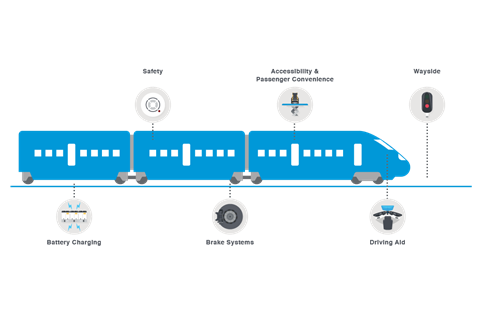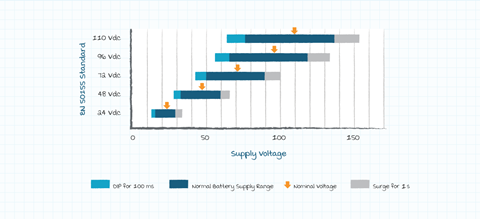In rail applications, the power selection is an important consideration for the proper functioning of the system. The power required for a rail application will depend on several factors such as the weight of the train, the speed at which it is traveling, and the terrain over which it will be traveling.
The power source for a rail system can be either electric or diesel, with electric power typically being more efficient and environmentally friendly. In addition, the power transmission and distribution systems for a rail system also need to be carefully designed to ensure that the train has a consistent and reliable source of power.
Power converter design considerations for rail applications
Regardless of what power generation is used, selecting the appropriate ac/dc and dc/dc converters is crucial for ensuring the proper functioning of modern electronics in rail applications. These converters are responsible for converting the power from the train’s power source (usually electric or diesel) into a form that can be used by the various electronic systems on board.
The key concerns for converter selection in rail applications include:
- High reliability and long lifespan, as trains are in constant use and downtime can be costly
- Wide input voltage range to accommodate for voltage fluctuations and fluctuations in the electrical grid
- High efficiency to minimize energy loss and reduce the need for cooling
- Robustness and ability to withstand harsh environmental conditions such as vibration and temperature changes
- Compliance with industry standards, such as EN 50155 and EN 45545
- Safety features like over-voltage protection and short-circuit protection
- Size and weight constraints
By carefully considering these factors, rail companies can select converters that will enable the safe and reliable operation of modern electronics and passenger amenities on trains.
The rail market
Global interest in both passenger and freight rail has been increasing over the last few years, which is highlighted by a 2022 report from McKinsey & Company. While the pandemic has stymied rail travel all over the globe, it is on track to becoming the preferred choice for travel in both Europe and North America. To that end, rail companies are consequently automating, as well as adding more features that will appeal to passengers. A partial list includes monitoring systems (and associated sensors), air conditioning, on-board communications systems (including cell repeaters and Wi-Fi), USB power ports, and infotainment systems.

Figure 1: Examples of electronic applications in modern rail systems
The electronics for these systems require a clean, isolated, uninterrupted supply of power, which isn’t immediately available on trains. Normally, the source of power for electronics in rail applications takes advantage of heavy-duty industrial batteries, which are designed to drive starter motors, relays, and switchgear. Yes, train batteries can produce noisy and fluctuating power which can damage delicate electronic devices such as microprocessors, microcontrollers, and semiconductor sensors. To address this issue, a preconditioning stage is typically used to handle the long high energy surges and high voltage spikes on the dc buses in trains. This leaves just the wide continuous operating voltage to contend with.
To that end, train battery voltage may be conditioned, but it still needs to be converted by a variety of dc/ac inverters and dc/dc converters to the voltages required by each type of electronic device being powered. As rail companies install more electronics in their trains, they need that many more converters delivering a wider range of voltages.
Converters and rail applications
The use of converters in trains adds an additional layer of complexity as they must be able to withstand a range of harsh environmental conditions including shock and vibration, temperature and humidity stress, fire and smoke, and electromagnetic interference (EMI). Additionally, converters must be able to handle electrical conditions such as voltage surges and transients, wide input voltage variations, and voltage interruptions, which can vary depending on their location and application within the train. This requires the use of specialized, ruggedized converters that are specifically designed to meet the unique needs of the railway industry.
Standards organizations have developed test standards that address each and every one of these concerns. Some of the key standards that apply are EN 50155 and EN 50121-3-2, though there are others.
- EN 50155 is a European standard with international support; it covers specification requirements ranging from operating temperature, vibration, shock, humidity, I/P voltage ranges, and EMC that electronic equipment must meet.
- EN 50121 is a corollary standard that covers the EMC aspects that equipment should comply with, including conducted and radiated emissions, fast transient bursts, surge, and conducted RF.
Commercial off-the-shelf solutions rarely fit the specification, especially for long term reliability. When selecting converters for rail applications, it is best to choose converters engineered specifically for the application. Another complication is that even though a dc/dc converter may list EN50155 compliance, users should ensure that it was tested to the appropriate level for the intended applications. For example, ensuring that the input voltage range is correct for the nominal battery voltage in the application.
Those looking for converter solutions might consider trusted manufacturers that offer commercial dc/dc converters that cover an entire range of voltages. As noted above, power on rail dc buses can fluctuate significantly. Most industrial converters are all engineered to handle fluctuations from 0.6x to 1.25x of nominal. The nominal range of these types of converters covers the extended range defined by rail standards. For example, a 110 VDC, EN 50155 nominal input can range from 77 to 137.5 VDC.

Figure 2: Input Voltage Supply Ranges
Isolated, chassis-mounted parts are typically available from 150 W to 300 W with input ranges of 14.4 – 50.4 VDC and 43.2 – 154 VDC covering nominals of 24 V, 28 V, 36 V, 72 V, 96 V and 110 VDC with brown-outs to 0.6 x Vnom and surges to 1.4 x Vnom. 500 W and 1000 W parts are also available with inputs of 43.2 – 100.8 VDC for 72 VDC nominal and 66 – 154 VDC for the 110 VDC nominal input also covering 0.6 x Vnom brown-outs and 1.4 x Vnom surges.

Figure 3: RCM-1000 series converters
Some converters also provide active current sharing. They accomplish this by connecting converter outputs in parallel for extra power or redundancy with associated signaling. The feature enables scaling, as any given system can double or triple the power in this manner. On the input side, the voltage range of the converters will often be wide to encompass as many nominal battery voltages as possible with their dips and surges. The converters are also protected against reverse polarity of the input and can ride through supply voltage interruptions lasting up to 10ms.
Considerations for DC-DC converter selection
When choosing converters, reliability and serviceability are also important considerations. When choosing converters for train applications, it is important to consider the following factors:
- Environmental conditions: The converter must be able to withstand the harsh environmental conditions found in trains, such as vibration, temperature and humidity stress, fire and smoke, and EMI.
- Electrical conditions: The converter must be able to handle electrical conditions such as voltage surges and transients, wide input voltage variations, and voltage interruptions.
- Safety and reliability: The converter must meet relevant safety standards and be reliable enough to operate in the demanding railway environment.
- Efficiency and power density: The converter should have a high efficiency and power density to minimize the size and weight of the system and reduce energy consumption.
- Customization: The converter should be customizable to meet the specific requirements of the train application, such as voltage level, current rating, and control interface.
- Certifications: The converter should have the necessary certifications and approvals, such as EN 50155, EN 45545, and EN 50121, to ensure compliance with railway industry standards.
It’s important to work with experienced suppliers, who can provide guidance and support in the selection and implementation of converters for train applications.
By Silvan Mueller, Business Development Manager, Bel Power Solutions

















